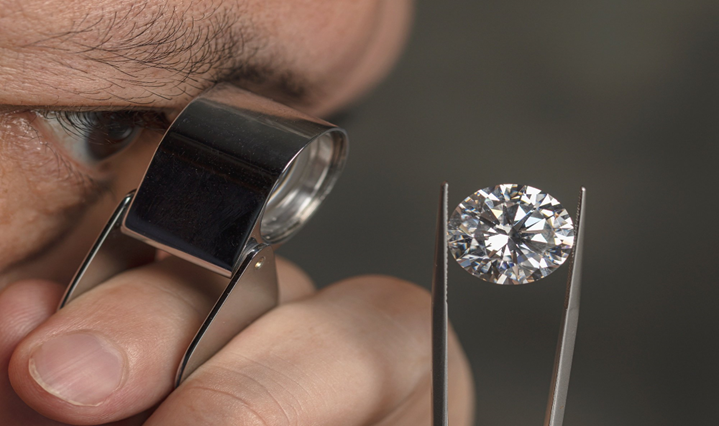כיצד לבדוק יהלום עם זכוכית מגדלת (לופה) כמו מקצוען
אם אתה שוקל לרכוש יהלום, בדיקה בעזרת לופה (זכוכית מגדלת של תכשיטנים) היא אחד הכלים החשובים שיכולים לעזור לך להבין את איכות האבן — ולמנוע אכזבות לאחר הרכישה. בעזרת תרגול קצר, גם אדם ללא ניסיון קודם יכול ללמוד לזהות פגמים, תכלילים וסימנים שיסייעו לו לקבל החלטה חכמה.
מהי לופה ואיך משתמשים בה?
לופה היא זכוכית מגדלת בעלת הגדלה של פי 10 (x10), המאפשרת לראות את פרטי היהלום בצורה מדויקת. זוהי הכלי הסטנדרטי שבו משתמשים גמולוגים, צורפים ותכשיטנים בכל העולם.
שלב אחר שלב: כך תשתמש בלופה בצורה נכונה
-
הכן את הסביבה
-
ודא שאתה יושב מול שולחן יציב ומואר היטב.
-
הנח את המרפקים על השולחן כדי לייצב את הידיים.
-
ודא שהידיים שלך נקיות. מגע בידיים שומניות או מלוכלכות עלול ללכלך את האבן.
-
-
החזקת הלופה
-
החזק את הלופה קרוב מאוד לעין שלך — ממש במרחק נגיעה מהפנים.
-
השאר את שתי העיניים פתוחות, כדי למנוע מאמץ מיותר.
-
חשוב לשמור על הלופה יציבה כל הזמן – אין להזיז אותה, אלא את היהלום.
-
-
החזקת היהלום
-
ביד השנייה החזק את היהלום בעדינות.
-
אם יש ברשותך פינצטה לתכשיטנים — עדיף להשתמש בה (דורש מעט תרגול).
-
קרב את היהלום באיטיות ללופה עד שתגיע למרחק שבו התמונה חדה וברורה.
-
-
כוונון הפוקוס
-
אם התמונה מטושטשת, הזז את היהלום פנימה והחוצה עד לקבלת מיקוד מושלם.
-
שמור על תנועה עדינה ומבוקרת.
-
-
בדיקת היהלום
-
בדוק תחילה את פני האבן (table) – החלק העליון והשטוח.
-
בדוק מזוויות שונות – סובב את היהלום כדי לראות את הפאות, הקצה (girdle) והעומק.
-
חפש תכלילים, סדקים, או פגמים פנימיים/חיצוניים.
-
שווה בין מה שאתה רואה לבין תעודת הדירוג (כגון GIA או SGL) — אם יש הבדלים, שאל את הצורף להסבר.
-
טיפים חשובים:
-
תכלילים הם תופעה טבעית ביהלומים, אך סוגם, מיקומם וגודלם משפיעים על ערך היהלום.
-
יהלומים בדרגות ניקיון גבוהות (כגון VVS או IF) ייראו "נקיים" גם בלופה, אך יהלומים בדרגות נמוכות יותר (כגון SI או I) יחשפו תכלילים ברורים.
-
אם אינך בטוח בפרשנות שלך — אל תהסס לפנות לאיש מקצוע מוסמך.

מה לחפש בעת בדיקת יהלום?
על תכלילים, שקיפות ואיכות מבנית
בעת בדיקת יהלום, בין אם בעין בלתי מזוינת ובין אם באמצעות זכוכית מגדלת (לופה), חשוב לדעת מה לחפש. לא כל פגם שנראה לעין הוא קריטי, אך ישנם תכלילים שעשויים לפגוע לא רק ביופי של האבן — אלא גם בשלמות המבנית שלה.
מה הם תכלילים?
תכלילים (Inclusions) הם סימנים פנימיים טבעיים הנוצרים בזמן שהיהלום מתגבש בעומק של 120–80 מייל מתחת לפני הקרקע. הם מעין "טביעת אצבע" של האבן, עדות לתהליך הטבעי והבלתי ניתן לשחזור שעבר עליה במשך מיליוני שנים.
למרות היותם טבעיים, חלק מהתכלילים עלולים להשפיע על איכות האבן — ויש לדעת כיצד לזהותם ולפרש את משמעותם.
תכלילים שאינם מזיקים
לא כל תכליל מהווה בעיה. דוגמה לכך היא:
-
נקודות שחורות – נגרמות מאזורים שבהם הפחמן לא עבר גבישיות מלאה. הן לרוב קטנות מאוד, ולעיתים בלתי נראות ללא הגדלה.
✦ אמנם מדובר בפגם אופטי, אך אין להן השפעה מבנית מהותית. -
עננים קלים או נימי משי – יכולים להופיע ביהלומים בעלי דרגות ניקיון נמוכות יותר, אך כאשר הם פזורים ולא מרוכזים באזור מסוים, הם לרוב אינם פוגעים בברק הכללי של היהלום.
תכלילים בעייתיים שיש להיזהר מהם
כדי לבחור יהלום איכותי שיישאר יפה ועמיד לאורך שנים, חשוב לזהות תכלילים מסוכנים, ובמיוחד:
1. גבישים כהים או צפופים
-
גבישים כהים בתוך היהלום עשויים לחסום את אור השמש, ולגרום להפחתת הברק, האש והניצוץ.
-
כאשר הם ממוקמים במרכז האבן (מתחת לטייבל), הם פוגעים במראה הכללי הרבה יותר מאשר אם הם בשוליים.
2. "נוצות" (Feathers)
-
נוצות הן סדקים קטנים בתוך היהלום, אשר לעיתים מגיעים עד פני השטח.
-
נוצות ארוכות או עמוקות במיוחד עלולות להחליש את המבנה הכללי של היהלום.
-
זהירות: נוצות הפוגעות בגבול האבן (girdle) עלולות להפוך אותה לפגיעה יותר בשימוש יומיומי — בעיקר בטבעות.
3. סדקים עמוקים או שברים גלויים
-
סדקים עמוקים, במיוחד כאלה שנראים לעין בלתי מזוינת, עלולים להוות סיכון ממשי לשבירה של היהלום במקרה של מכה או לחץ.
-
יהלום איכותי אינו אמור להכיל סדקים מבניים משמעותיים.
מה חשוב לזכור?
-
תכלילים מסוימים עשויים דווקא להעיד על כך שמדובר ביהלום טבעי ולא סינתטי — אך רצוי שהיו מינוריים ובמקומות שאינם בולטים.
-
אין פסול ביהלום עם תכליל – השאלה המרכזית היא: כמה הוא משפיע על הברק, הצורה והעמידות.
-
בדקו תמיד את מה שאתם רואים מול תעודת הדירוג — ודאו שהדירוג משקף את המציאות.
-
אם אינכם בטוחים – התייעצו עם גמולוג מוסמך.
לסיכום:
בדיקת תכלילים ביהלום היא שלב קריטי ברכישה מושכלת. יהלום עם תכלילים קלים יכול להיות בחירה חכמה ומשתלמת, אך תכלילים בעייתיים — במיוחד סדקים או נוצות המגיעים לשוליים — עלולים לגרום לפגיעה בערך וביציבות של האבן לאורך זמן. כך שבדיקת יהלום עם לופה היא דרך נגישה ואפקטיבית להבין את איכות האבן שאתה עומד לרכוש. אמנם נדרש תרגול כדי לפתח עין מיומנת, אך עם מעט סבלנות — תוכל לזהות בעצמך פרטים שיסייעו לך לקבל החלטה נכונה ובטוחה.
ב־Get-Jewel.com אנו בודקים כל יהלום בקפידה, ומספקים לך תעודת גמולוגיה ואימות מקצועי כדי שתוכל לבחור בביטחון מוחלט.
רוצה לדעת עוד על איך לבדוק יהלומים, להבין תעודות או להבדיל בין יהלום טבעי לסינתטי? אנחנו כאן בשבילך.


